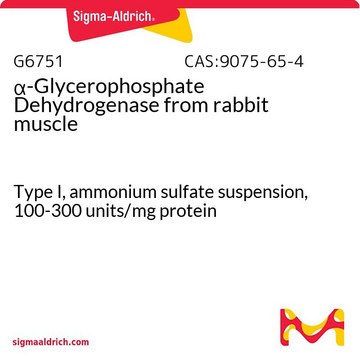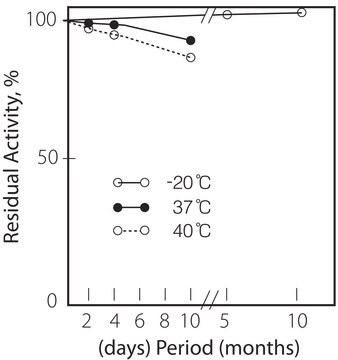T6258
Triosephosphate Isomerase from rabbit muscle
Type X, lyophilized powder, ≥3,500 units/mg protein
Synonyme(s) :
D-Glyceraldehyde-3-phosphate ketol-isomerase, TPI
About This Item
Produits recommandés
Type
Type X
Forme
lyophilized powder
Activité spécifique
≥3,500 units/mg protein
Poids mol.
calculated mol wt 53.2 kDa
Composition
Protein, 60-90% biuret
Activité étrangère
pyruvate kinase, lactic dehydrogenase, 3-phosphoglyceric phosphokinase, phosphoglucose isomerase, α-glycerophosphate dehydrogenase, aldolase and glyceraldehyde-3-phosphate dehydrogenase ≤0.01%
Température de stockage
−20°C
Vous recherchez des produits similaires ? Visite Guide de comparaison des produits
Description générale
Application
Actions biochimiques/physiologiques
Conditionnement
Définition de l'unité
Forme physique
Code de la classe de stockage
11 - Combustible Solids
Classe de danger pour l'eau (WGK)
WGK 3
Point d'éclair (°F)
Not applicable
Point d'éclair (°C)
Not applicable
Équipement de protection individuelle
Eyeshields, Gloves, type N95 (US)
Certificats d'analyse (COA)
Recherchez un Certificats d'analyse (COA) en saisissant le numéro de lot du produit. Les numéros de lot figurent sur l'étiquette du produit après les mots "Lot" ou "Batch".
Déjà en possession de ce produit ?
Retrouvez la documentation relative aux produits que vous avez récemment achetés dans la Bibliothèque de documents.
Les clients ont également consulté
Notre équipe de scientifiques dispose d'une expérience dans tous les secteurs de la recherche, notamment en sciences de la vie, science des matériaux, synthèse chimique, chromatographie, analyse et dans de nombreux autres domaines..
Contacter notre Service technique













